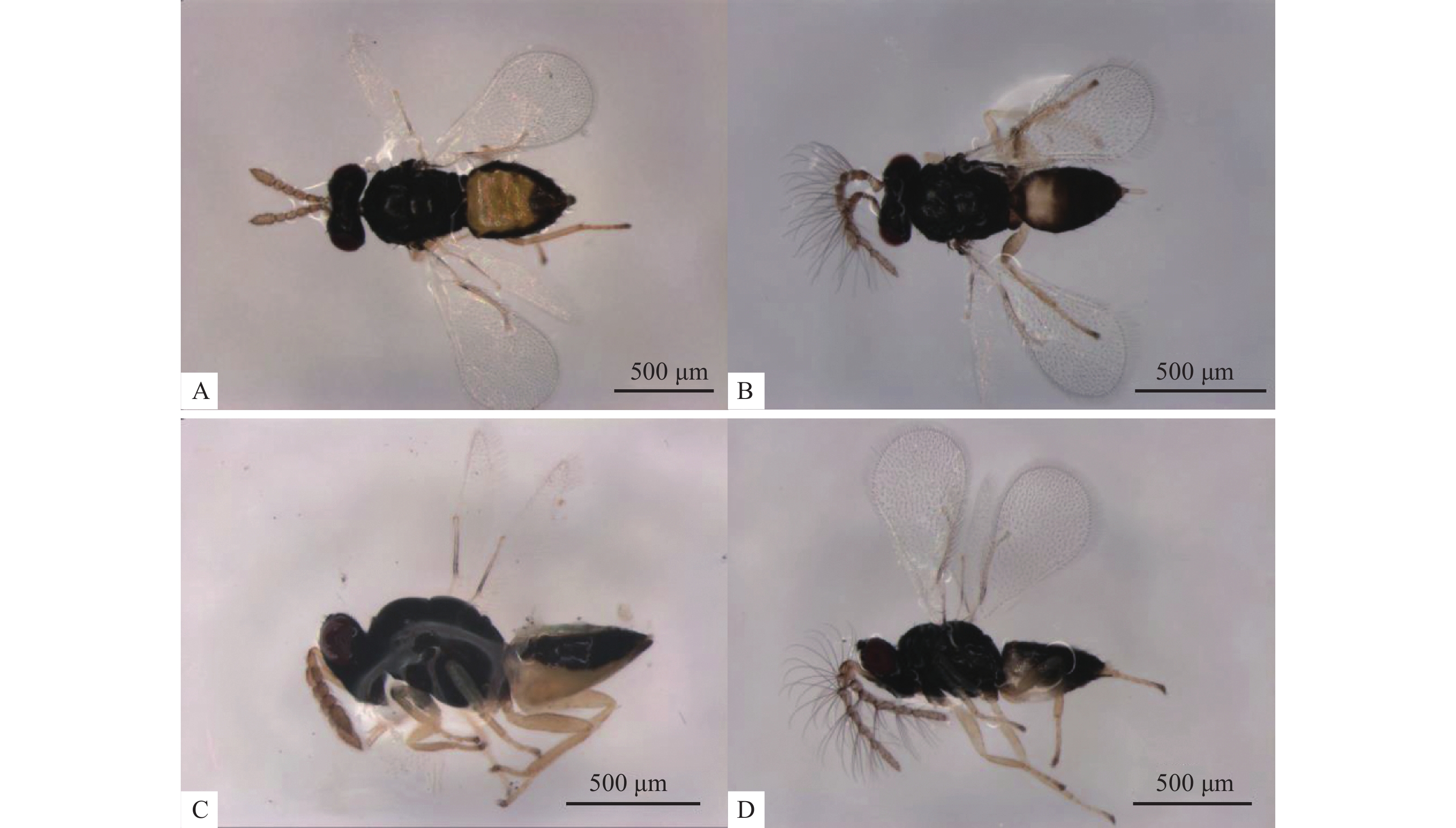Morphology and parasitic behavior of Tamarixia radiata at different development stages
-
摘要:目的
研究柑橘木虱Diaphorina citri优势寄生蜂亮腹釉小蜂Tamarixia radiata的个体发育形态学及寄生行为,为柑橘黄龙病的生物防控提供理论和技术指导。
方法在温度为(26±1) ℃、相对湿度为60%~80%的试验条件下,观察亮腹釉小蜂寄生行为及个体发育形态,并测量形态学指标。
结果亮腹釉小蜂寄生柑橘木虱3~5龄若虫产卵;亮腹釉小蜂整个发育历程分为卵、幼虫、蛹、成虫4个阶段;室内条件下其世代发育历期约为13.40 d;雌虫个体明显大于雄虫;雄虫触角刚毛发达,几乎覆盖整个触角基节,而雌虫触角刚毛很短,触角基节清晰可见;雌虫腹部背面黄色区域明显大于雄虫。
结论亮腹釉小蜂为柑橘木虱体外寄生蜂,雌、雄成虫形态有显著差异。
Abstract:ObjectiveTo study the ontogenetic morphology and parasitic behavior of Tamarixia radiata, the predominant parasitoid of Diaphorina citri, and provide theoretical and technical information for sustainable management of Huanglongbing.
MethodThe parasitic behavior and ontogenetic morphology of T. radiata were observed under laboratory conditions of (26±1) ℃ and 60% to 80% relative humility and natural lighting. Morphologic indexes of T. radiata were measured.
ResultThe adult T. radiata females lay eggs on 3rd to 5th instar nymphs of D. citri. The life cycle of T. radiata includes the egg, larva, pupa and adult stages. The developmental duration is about 13.40 d under laboratory condition. The females are distinctly larger than males in body size. The setae of male antennas are well developed and almost cover all the antenna segments, while the setae of female antennas are short and the antenna segments are clearly visible. The yellow area on the dorsal surface of female abdomen is obviously larger than that of male.
ConclusionT. radiata is an ecto-parasitoid of D. citri. There are significant morphological differences between T. radiata female and male adults.
-
Keywords:
- Diaphorina citri /
- Tamarixia radiata /
- parasitic behavior /
- developmental morphology /
- biocontrol
-
-
表 1 亮腹釉小蜂成虫形态1)
Table 1 The morphology of Tamarixia radiata adult
μm 成虫 体长 体宽 头长 头宽 雌虫 1 092.35±9.92a 383.71±7.51a 167.04±1.73a 392.29±7.46a 雄虫 971.24±31.14b 328.82±13.36b 141.10±6.84b 351.19±10.16b 1)表中数据为平均值±标准误,同列数据后凡具有一个相同字母者,表示差异不显著 (P>0.05,t 检验)。 -
[1] BOVÉ J M. Huanglongbing: A destructive, newly-emerging, century-old disease of citrus[J]. J Plant Pathol, 2006, 88(1): 7-37.
[2] HALL D G, RICHARDSON M L, AMMAR E D, et al. Asian citrus psyllid, Diaphorina citri, vector of citrus Huanglongbing disease[J]. Entomol Exp Appl, 2013, 146(2): 207-223.
[3] 代晓彦, 李翌菡, 许炜明, 等. 亚洲柑橘木虱 2 株高致病力病原真菌菌株的筛选[J]. 华南农业大学学报, 2016, 37(5): 62-65. [4] 代晓彦, 李翌菡, 沈祖乐, 等. 球孢白僵菌与玫烟色棒束孢制剂对柑橘木虱的防治[J]. 华南农业大学学报, 2017, 38(1): 63-68. [5] HODDLE M S, HODDLE C D. Classical biological control of Asian citrus psyllid with Tamarixia radiata in urban Southern California[J]. Citrograph, 2013, 4(2): 52-58.
[6] SULE H, MUHAMAD R, OMAR D, et al. Parasitism rate, host stage preference and functional response of Tamarixia radiata on Diaphorina citri[J]. Int J Agric Biol, 2014, 16(4): 783-788.
[7] CHIEN C C. The role of parasitoids in the pest management of citrus psyllid[C]//Proceedings of the Symposium on Research and Development of Citrus in Taiwan. Taiwan: Taichung, 1995: 245-261.
[8] 代晓彦, 任素丽, 周雅婷, 等. 黄龙病媒介昆虫柑橘木虱生物防治新进展[J]. 中国生物防治学报, 2014, 30(3): 414-419. [9] BARR N B, HALL D G, WEATHERSBEE A A, et al. Comparison of laboratory colonies and field populations of Tamarixia radiata, an ecto-parasitoid of the Asian citrus psyllid, using internal transcribed spacer and cytochrome oxidase subunit I DNA sequences[J]. J Econ Entomol, 2009, 102(6): 2325-2332.
[10] YANG Y P, HUANG M D, BEATTIE G A, et al. Distribution, biology, ecology and control of the psyllid Diaphorina citri Kuwayama, a major pest of citrus: A status report for China[J]. Int J Pest Manage, 2006, 52(4): 343-352.
[11] QURESHI J A, ROGERS M E, HALL D G, et al. Incidence of invasive Diaphorina citri(Hemiptera: Psyllidae) and its introduced parasitoid Tamarixia radiata (Hymenoptera: Eulophidae) in Florida citrus[J]. J Econ Entomol, 2009, 102(1): 247-256.
[12] PARRA J R P, ALVES G R, DINIZ A J F, et al. Tamarixia radiata (Hymenoptera: Eulophidae) ×Diaphorina citri(Hemiptera: Liviidae): Mass rearing and potential use of the parasitoid in Brazil[J]. J Integr Pest Manag, 2016, 7(1): 5.
[13] 钱景秦, 朱耀沂, 古琇芷. 亮腹釉小蜂(Tamarixia radiata)之形态, 生活史及其寄生策略[J]. 中华昆虫, 1991, 11(4): 264-281. [14] TEXEIRA D D C, AYRES J, KITAJIMA E W, et al. First report of a Huanglongbing-like disease of citrus in São Paulo State, Brazil and association of a new Liberibacter species, “Candidatus Liberibacter americanus”, with the disease[J]. Plant Dis, 2005, 89(1): 107.
[15] MEYER J M, HOY M A. Molecular survey of endosymbionts in Florida populations of Diaphorina citri (Hemiptera: Psyllidae) and its parasitoids Tamarixia radiata (Hymenoptera: Eulophidae) and Diaphorencyrtus aligarhensis (Hymenoptera: Encyrtidae)[J]. Fla Entomol, 2008, 91(2): 294-304.
[16] GÓMEZ-TORRES ML, NAVA D E, PARRAJ R P. Life table of Tamarixia radiata (Hymenoptera: Eulophidae) onDiaphorina citri (Hemiptera: Psyllidae) at different temperatures[J]. J Econ Entomol, 2012, 105(2): 338-343.
[17] 章玉苹, 李敦松, 黄少华, 等. 柑桔木虱的生物防治研究进展[J]. 中国生物防治学报, 2009, 25(2): 160-164. [18] HOY M A, NGUYEN R, JEYAPRAKASH A. Classical biological control of Asian citrus psyllid in Florida[J/OL]. Integrated Pest Management Florida: University of Florida. (2012-03-13) [2016-10-10]. http://ipm. ifas.ufl. edu/agriculture/citrus/psyllid.shtml.
[19] SKELLEY L H, HOY M A. A synchronous rearing method for the Asian citrus psyllid and its parasitoids in quarantine[J]. Biol Control, 2004, 29(1): 14-23.
[20] MANN R S, QURESHI J A, STANSLY P A, et al. Behavioral response of Tamarixia radiata Waterston (Hymenoptera: Eulophidae) to volatiles emanating from Diaphorina citri Kuwayama (Hemiptera: Psyllidae) and citrus[J]. J Insect Behav, 2010, 23(6): 447-458.




 下载:
下载:

